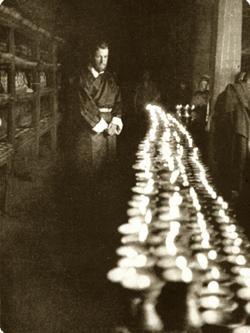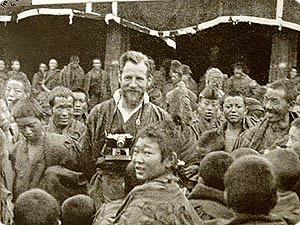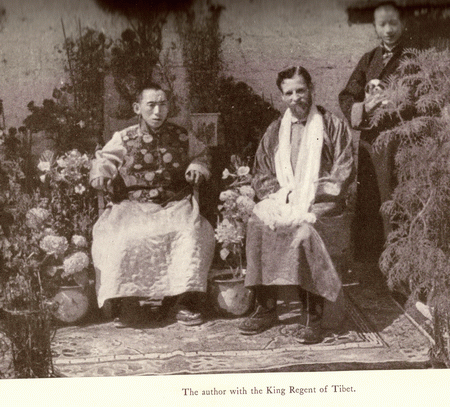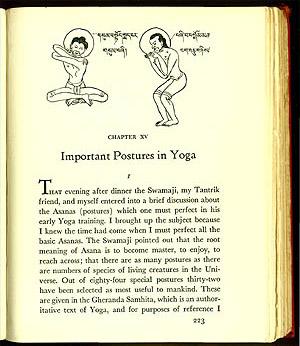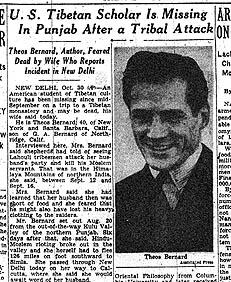“The
fact is, I, the person about to be initiated into Tibetan
sacred mysteries, was no native, no Tibetan, not even an
oriental, but an American, hailing from Arizona. And here,
at the end of the ceremony, I would become a full-fledged
Buddhist monk, a Lama.” The story of Theos Bernard begins
in the deserts of southern Arizona. Raised by his mother in
Tombstone, Bernard entered the newly founded University of
Arizona, in Tucson, in 1928. Bernard’s early college years
were interrupted, however, by a near fatal illness which
profoundly altered his life. It was while convalescing in
the Dragoon Mountains that Bernard met his first spiritual
teacher, a yogi from India who had been a friend of his
family for many years, who began to instruct him in the
fundamentals of yoga. Although he had been pursuing a degree
in law, Bernard completed his studies in 1934 only to turn
to religious and philosophical pursuits. Theos Bernard entered Columbia
University in the fall of 1934, immediately following his
graduation from the University of Arizona. At the time of
his entry, there was no formal program of studies in
religion, and courses on the subject had only been being
taught for seven years, mostly through the efforts of
Bernard’s advisor in the philosophy department, Herbert
Schneider. The records of Bernard’s career during this time
are sparse, and his official transcript gives no account of
any classes taken or grades received, noting only that on
June 2, 1936, he was awarded the degree of Masters of Arts
(AM). Of his own account, though
Bernard’s first two publications are autobiographical and
tell the story of his education and pursuit of authentic
religious instruction, they give no account of his years at
Columbia. Rather, Heaven Lies Within Us and
Penthouse of the Gods were both published following
his trips to India and Tibet from 1936–37 and textually
laid the groundwork for his later books through the
narrative of a personally validated authentic religious
tradition. The full context of Bernard’s life story lies
unspoken in the world of his uncle, Pierre Bernard, and New
York’s high society of the 1920s and 1930s. Pierre Bernard (aka Oom the
Omnipotent) founded the New York Sanskrit College in midtown
Manhattan in the early part of the twentieth century.
Together with his wife, Blanche de Vries, Oom began
instructing a number of wealthy New York socialites in the
science and practices of yoga. Chief among Oom’s students
was Mrs. Vanderbilt, who funneled not only friends, but a
substantial amount of money his way to establish a discreet
sanctuary in which Oom could lecture and instruct. The
result was The Mystic Order of the Tantriks of India and an
estate that was to become the Clarkstown Country Club in
Nyack, New York. Here Oom did, indeed, lecture and instruct
on the practices of yoga–even publishing a
journal–but also provided a socially liberal yet
exclusive resort for young New Yorkers, and put at their
disposal a world-class research library described as
“approximately 7,000 volumes on the subjects of philosophy,
ethics, psychology, education and metaphysics as well as
much collateral material on physiology, medicine and the
related sciences.” More significantly however, Oom provided
his services—either directly or incidentally—as a
matchmaker for the membership. It was into this world that
he brought his nephew, Theos Bernard, who eventually married
a niece of Henry Morgenthau Sr., Viola Wertheim. “I had become aware of my
discovery of those deep joys that I had never before dreampt
existed in this life, and I felt that all my effort gained
for me a reward altogether overwhelming” India and Tibet
Completing his master’s degree in
1936, and with the financial leisure accorded him by his
marriage, Bernard was able to embark on an extensive trip to
India and Tibet in late summer of 1936. Narrating his
account, Bernard tells of seeking out the teacher of Hindu
yogi whom he had met once in Arizona through his mother.
Arriving in India in time only to hear of the death of his
would-be guru, Bernard sought out other teachers in India
traveling the length and breadth of the country, from Kasmir
to Ceylon (Sri Lanka) taking religious initiations and
instruction on various yogic techniques. He finally made his
way to Calcutta where he was able to make contacts which
eventually led to a meeting with and becoming a student of
Lama Tharchin in Kalimpong. Here, Bernard spent a period of
intensive study of the Tibetan written language and three
spoken dialects. After close to a year in India, he was
finally able to secure permission from the British political
officer in Sikkim, J. B. Gould to travel to Tibet. Once
there, Bernard had audiences with the Ganden Tri-pa, the
Regent of Tibet, Reting Rinpoche, and numerous other
officials in the Tibetan government. In addition, Bernard
received Tantric empowerments, engaged in a meditative
retreat, and acquired numerous books included a complete set
of the Buddhist canon, a set of the Treasury of Revealed
Teachings (rin chen gter mdzod) and several hundred more
volumes of Tibetan works. Shortly after returning from India
and Tibet, Theos Bernard was divorced by his wife Viola.
Completing his first two books, Bernard began touring,
giving a series of lectures in America and Europe. Promoting
himself and his new books in England, Bernard authored
several magazine articles both about the political situation
in Tibet and his experiences there. In conjunction with the
British publication of Penthouse of the Gods (published
under the title of Land of a Thousand Buddhas), Bernard’s
accounts were picked up by the British tabloid press at the
time, and, though their sensationalistic reports concerning
his identity as “a white Lama” garnered some positive public
feedback and interest, it also earned him the scorn and
private dismissal of British Intelligence operatives (who
had monitored his activities since his first entry into
Tibet) as a fraud and imposter. In the West, there is the
preconceived notion that man cannot know metaphysical truths
by direct experience; therefore, at best, metaphysical
truths can only be speculations, inferences, or ungrounded
faith.
Returning to America, Bernard
continued working on his dissertation at Columbia
University, Hatha Yoga: The Report of a Personal
Experience (1943). He began teaching and lecturing on
yoga on the Upper East side of Manhattan, where he met a
wealthy Polish opera star who first became one of his
students and, later, a romantic interest. Within a year,
Bernard and Ganna Walska were married and the two moved to
California where they purchased a large piece of land, which
they named Tibetland to house Bernard’s
collection of Tibetan manuscripts, provide accommodations
for visiting Tibetan lamas, and to serve as the center for
his translation efforts. Bernard’s marriage to Ganna
Walska was short lived, however. While Walska proceeded to
convert the property into a horticultural museum
(Lotusland), Bernard produced a fourth book, The
Philosophical Foundations of India, and together with
his third wife, Helen, returned to India in 1947, this time
seeking “rare manuscripts” in the hills of Spiti near
Ladakh. Entering the Punjab en route to his destination, his
party of Muslim porters was rumored to have been attacked by
Lahouli tribesman. Conflicting reports about his whereabouts
circulated for several months, and though his wife waited
for him in Calcutta, he never returned. Despite his talents
and good fortunes which had led him so far, in the end
Bernard never saw his aspirations fulfilled and, like Tibet,
fell victim to the larger forces at play during the twilight
of the old empires. Excerpted from the forthcoming
article “The Life and Works of Theos Bernard” by
Paul G. Hackett. More on Theos Bernard on
Beezone Theo
Bernard Flyer by W. Colston
Leigh, Inc.
